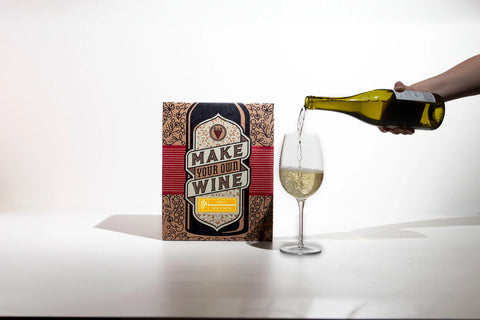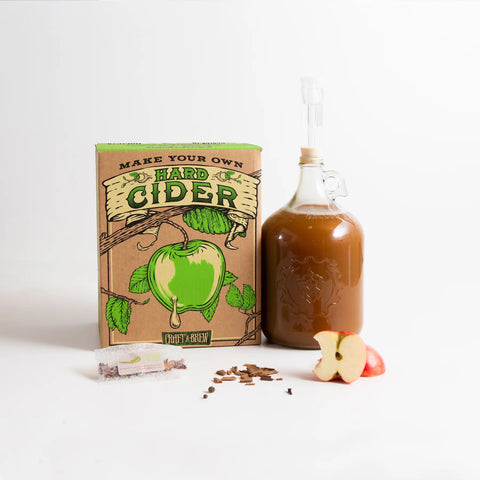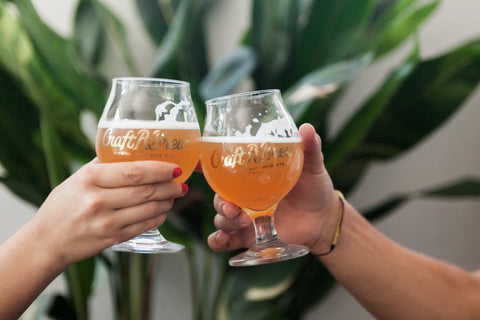TL;DR: Best Yeasts for Wine Making
-
Yeast is the engine behind wine fermentation, converting sugars into alcohol. It also shapes the final flavor, aroma and sometimes the body of your wine - so choose wisely!
-
Champagne yeasts bring crisp, dry finishes and high alcohol tolerance.
-
Red wine yeasts emphasize body, tannin, and complex flavors.
-
White wine yeasts enhance fruitiness and aroma.
-
Mead yeasts balance delicate honey notes with clean fermentation.
-
The best yeast depends on your wine style and flavor goals.
Why Yeast Choice Matters in Winemaking
While fruit or honey are the building blocks of your wine, yeast is what transforms those ingredients into wine. Every yeast behaves differently and produces different flavors, aromas or alcohol content. When choosing wine yeast, you should consider:
-
Fermentation speed - some strains race to the finish line, while others move more slowly.
-
Alcohol tolerance - Champagne and Premier Blanc yeasts, for example, can handle up to 18% ABV.
-
Residual sweetness - slow or stuck fermentations can leave sugars behind, creating sweeter wines.
-
Aromas and flavor complexity - fruity esters, clean neutral finishes, or rich tannic depth all come from yeast activity.
You can make the same batch of juice with different yeasts and end up with completely different wines. That’s why understanding yeast selection is one of the most important craft beer brewing tips that also applies to wine and mead making.
Champagne Yeasts: Crisp and Clean
When most people think of Champagne yeast for wine, they think of sparkling, effervescent bottles. But these strains are useful well beyond sparkling wines. Champagne strains are some of the best yeasts for wine making because of their reliable fermentation, clean, neutral flavor contribution and a reliably dry finish.
Lalvin EC-1118 Champagne Yeast for Wine
Best for: Sparkling wines, dry whites, hard ciders, hard seltzers or any high-alcohol fermentations.
Characteristics:
-
Strong fermentation power with low foaming
-
High alcohol tolerance (up to ~18%)
-
Neutral flavor profile - contributes very little aroma or ester character
-
Leaves beverages clear due to good flocculation
Red Star Premier Cuvee Champagne Yeast for Wine
Best for: Traditional sparkling wines, Chardonnays, Cabernet Sauvignon, and even soda carbonation.
Characteristics:
-
Clean, neutral fermentation that emphasizes grape character
-
High alcohol tolerance (up to 16%)
-
Performs well in difficult or stuck fermentations
-
Adds roundness to texture and mouthfeel
👉 Shop Red Star Premier Cuvee Yeast
Red Wine Yeasts: Body and Complexity
Red wine yeast strains tend to enhance rich red grape character, support tannin development, and encourage deeper colors in bold reds. Each strain emphasizes different aspects of body and aroma. Whether you want to enhance a bold grape’s flavor profile, or need to amp up the complexity of a delicate grape, these red wine yeast strains are up for the task.
Red Star Premier Rouge Red Wine Yeast
Best for: Cabernet Sauvignon, Merlot, Zinfandel, barrel-aged or oak-aged reds
Characteristics:
-
One of the best strains for fermenting red wines
-
Promotes intense dark fruit aromas
-
Enhances lighter grape varietals
-
Alcohol tolerance up to 15%
👉 Shop Red Start Premier Rouge Yeast
Red Star Premier Classique Red Wine Yeast
Best for: Bordeaux varietals, oak barrel fermentations, and full-bodied reds. Can be used in whites or rosés, too.
Characteristics:
-
Neutral strain with medium fruity aroma intensity
-
Clean fermentations that showcase oak influence
-
Alcohol tolerance up to 15%
👉 Shop Red Star Premier Classique Yeast
Lalvin 71B Red Wine Yeast
Best for: Fruity, approachable reds, rosés & darker fruit wines.
Characteristics:
-
Produces high levels of esters for fruity aromas
-
Consumes some malic acid, resulting in a smoother, less “sour” wine
-
Alcohol tolerance up to 14%
-
Short lag phase for quick fermentation starts
White Wine Yeasts: Fruity and Aromatic
White wine yeasts are designed to emphasize delicate aromas and preserve fruitiness. Whites need wine fermentation yeast that enhances aromatics and supports a clean, crisp finish.
👉 White wine yeasts are perfect for crafting refreshing, fruit-forward wines that highlight grape varietals.
Lalvin D47 White Wine Yeast
Best for: White wines, rosés, and meads
Characteristics:
-
Adds body and a soft, silky mouthfeel
-
Contributes slight citrus and tropical fruit notes
-
Alcohol tolerance up to 14%
-
Flexible fermentation temperature range: 59-86ºF.
Red Star Premier Cote des Blancs White Wine Yeast
Best for: Sauvignon Blanc, Riesling, Chardonnay, Gewürztraminer, sweet whites, fruit wines, apple wines & hard ciders
Characteristics:
-
Slow fermenter that enhances fruit character and aroma
-
Lower alcohol tolerance (12-14%)
-
Great for sweet or aromatic wines
👉 Shop Red Star Premier Cote des Blancs Yeast
Lalvin K1-V1116 White Wine Yeast
Best for: Aromatic whites, sparkling wines, and fruit wines
Characteristics:
-
Vigorous, quick fermenter with strong floral ester production
-
Excellent for neutral juices that need flavor complexity
-
Alcohol tolerance up to 18%
-
Performs well in extreme temperature conditions (50–95ºF)
Red Star Premier Blanc White Wine Yeast
Best for: High alcohol white, fruit or red wines
Characteristics:
-
An excellent all-purpose yeast
-
Extremely high alcohol tolerance of 18%
-
Wide, flexible fermentation temperature range: 50-86ºF
-
Helpful for treating stuck fermentations
👉 Shop Red Star Premier Blanc Yeast
Mead Yeast Strains: Balancing Honey & Alcohol
Because honey lacks nutrients, mead yeast strains must be chosen carefully to ensure a healthy fermentation.
Honey has little natural nutrient content, so choosing the right mead yeast strains ensures a healthy fermentation that highlights honey’s character.
👉 For mead making, yeast selection impacts whether your mead is dry, semi-sweet, or dessert-like.
Lalvin D47 Yeast
Best for: Traditional meads or high-alcohol “sack” meads
Characteristics:
-
Promotes fuller body & soft mouthfeel in honey wines
-
Contributes slight citrus and tropical fruit notes
-
Alcohol tolerance up to 14%
-
Flexible fermentation temperature range: 59-86ºF
Lalvin 71B Yeast
Best for: Fruited meads (melomels), traditional meads & more
Characteristics:
-
Fruity ester production complements honey and fruit additions
-
Reduces malic acid sourness for smoother meads
-
Alcohol tolerance up to 14%
-
Short lag phase for quick fermentation starts
Lalvin K1-V1116 Yeast
Best for: Sack (high-ABV) meads, meads made with floral honey
Characteristics:
-
Performs well in high-gravity musts
-
Adds floral esters and preserves honey character
-
Vigorous, quick fermenter with strong floral ester production
-
Alcohol tolerance up to 18%
-
Performs well in extreme temperature conditions (50–95ºF)
SafAle US-05 Yeast
Best for: Session (low-ABV) meads and traditional meads
Characteristics:
-
Ale yeast strain that performs exceptionally well in meads
-
Produces a neutral, clean fermentation profile that highlights honey and fruit
-
Fermentation temperature range: 54–77°F (ideal: 59–71°F)
-
Moderate alcohol tolerance, typically up to 11–12%
How to Choose Yeast for Wine
With so many options available, figuring out the best yeasts for wine making can feel overwhelming. The right choice depends on your ingredients, your desired style, and even your brewing environment. Here are some factors to guide your decision:
1. Base Material: Grapes, Fruits, or Honey
-
Red grapes: Bold varietals like Cabernet Sauvignon or Merlot often benefit from red wine yeast strains that enhance tannins and body.
-
White grapes: Sauvignon Blanc or Chardonnay shine with white wine yeast that emphasizes crispness and aromatics.
-
Fruit wines: Strawberries, apples, or peaches can be tricky—neutral strains or champagne yeast for wine usually let the fruit shine.
-
Mead: Since honey has little natural nutrient content, mead yeast strains like D47 or K1-V1116 help ensure fermentation stays healthy while balancing honey character.
2. Desired Wine Style
-
Dry wines: Choose neutral, high-alcohol-tolerant strains (like EC-1118) that ferment sugars completely.
-
Sweet wines: Go with slower fermenters (like Cote des Blancs) that leave some residual sugar.
-
Sparkling wines: Champagne yeast for wine is the standard thanks to its clean, crisp profile and strong performance under pressure.
-
Experimental or hybrid styles: Ale yeasts like SafAle US-05 can cross over into meads or fruit wines, offering fun, unexpected results.
3. Alcohol Tolerance
Think about your target ABV (alcohol by volume):
-
Session or low-ABV meads (6–10%): A strain like US-05 is a great fit.
-
Standard table wines (12–14%): Most red and white wine yeasts fall in this range.
-
High-gravity or fortified wines (15–18%): Premier Blanc or K1-V1116 are powerhouse strains that can handle it.
4. Flavor and Aroma Impact
Not all yeast is neutral. Many strains actively shape your wine:
-
Fruity esters: 71B adds juicy berry notes, while D47 lends citrus and tropical aromas.
-
Floral notes: K1-V1116 emphasizes floral esters, making it great for meads and aromatic whites.
-
Neutral finish: EC-1118 and Premier Blanc let fruit or oak shine without added yeast character.
5. Fermentation Conditions
Even the best yeasts for wine making won’t shine if your conditions are off. Temperature, nutrients, and oxygen levels all affect yeast performance. If your fermentation space runs warm or cool, choose a yeast with a wide temperature tolerance (like K1-V1116 or Premier Blanc).
👉 Pro Tip: A great way to learn about yeast’s impact on a wine is to ferment 2 identical batches side-by-side, each with a different yeast strain. Keep a log to compile your notes of each wine’s taste, aroma & body. Experimenting with different strains will help you learn how to choose yeast for wine that yields your ideal finished product.
Final Thoughts
The best yeast for wine making depends on your style and goals. Champagne yeast delivers reliable, dry fermentations. Red wine yeasts enhance complexity and depth. White wine yeasts highlight fruit and aroma. Mead yeasts preserve honey’s natural character.
By understanding yeast options, you’ll unlock more control over your homemade wine’s flavor, body, and balance.
👉 Ready to start fermenting? Explore our Wine Yeast Collection and Wine Making Kits to find the perfect pairing for your next batch.





